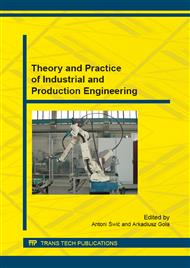[1]
M. Żenkiewicz, Analiza głównych metod badania swobodnej energii powierzchniowej materiałów polimerowych, Polimery, 52 (2007) 760-767.
DOI: 10.14314/polimery.2007.760
Google Scholar
[2]
M. Żenkiewicz, Methods for the calculation of surface free energy of solids, Journal of Achievements in Materials and Manufacturing Engineering, 24 (2007) 137-145.
Google Scholar
[3]
J. Domińczuk, Wpływ stanu energetycznego warstwy wierzchniej na wytrzymałość połączenia adhezyjnego, Postęp Nauki i Techniki, 13 (2012) 30-36.
Google Scholar
[4]
M. Żenkiewicz, Adhezja i modyfikowanie warstwy wierzchniej tworzyw wielkocząsteczkowych, Wydawnictwo Naukowo Techniczne, Warszawa, (2000).
Google Scholar
[5]
A. Rudawska, J. Kuczmaszewski, Klejenie blach ocynkowanych, Wydawnictwo Uczelniane Politechniki Lubelskiej, Lublin, (2005).
Google Scholar
[6]
A. Rudawska, Wybrane zagadnienia konstytuowania połączeń adhezyjnych jednorodnych i hybrydowych, Politechnika Lubelska, Lublin, (2013).
Google Scholar
[7]
A. Krawczuk, J. Domińczuk, The use of computer image analysis in determining adhesion properties, Applied Computer Science 3 (2014) 68-77.
Google Scholar
[8]
M. C. Michalski, J. Hardy, B. J. V. Saramango, On the surface free energy of PVC/EVA polymer blends: comparison of different calculation methods, Journal of Colloid and Interface Science, 208 (1998) 319-328.
DOI: 10.1006/jcis.1998.5814
Google Scholar
[9]
R. R. Deshmukh, A. R. Shetty, Comparison of surface energies using various approaches and their suitability, Journal of Applied Polymer Science 107(2007) 3707-3717.
DOI: 10.1002/app.27446
Google Scholar
[10]
R. Rogowska, Uproszczony sposób wyznaczania swobodnej energii powierzchniowej powłok osadzanych technika Arc-PVD, Problemy Eksploatacji, 1 (2013) 85-100.
Google Scholar
[11]
M. Żenkiewicz, New method of analysis of the surface free energy of polymeric materials calculated with Owens-Wendt and Neumann methods, Polimery, 7-8(2006) 584-587.
DOI: 10.14314/polimery.2006.584
Google Scholar
[12]
M. Żenkiewicz, Comparative study on the surface free energy of a solid calculated by different methods, Polymer Testing, 26 (2006) 14-19.
DOI: 10.1016/j.polymertesting.2006.08.005
Google Scholar
[13]
A. Rudawska, Adhesive Properties, Scanning Electron Microscopy, InTech, 2012, http: /www. intechopen. com/books/scanning-electron-microscopy/adhesive-properties.
DOI: 10.5772/37011
Google Scholar


